


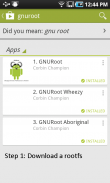
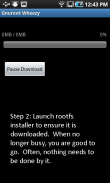
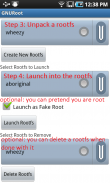
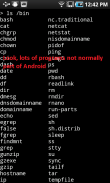
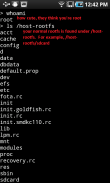
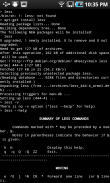
GNURoot

Beschreibung von GNURoot
GNURoot provides a method for you to install and use GNU/Linux distributions and their associated applications/packages alongside Android.
This does NOT require root.
A regular uninstall fully cleans up after this application.
This is expandable and you will be able to install your own applciations/packages.
Inside GNURoot, you can create a root file system), launch into it, or delete it.
Read the description of the GNURoot Wheezy, Gentoo, Fedora or Aboriginal apps in the Play Store to get some hints on how to get started using them.
https://play.google.com/store/apps/details?id=champion.gnuroot.wheezy
https://play.google.com/store/apps/details?id=champion.gnuroot.gentoo
https://play.google.com/store/apps/details?id=champion.gnuroot.fedora
https://play.google.com/store/apps/details?id=champion.gnuroot.aboriginal
The moto is: "This ain't done, until everything* will run"
*everything == all linux, user space applications, without having to root your device. Some things (a small number of things), that actually require root will not work (like inserting a kernel module).
Key goals:
Choice or GNU/Linux rootfs to start with:
Currently two choices, many more to come.
All applications that don't absolutely require root should function as normal:
apt-get now working.
Following step is to get a graphical interface for the desktop, terminal and applications. Currently, only launches an Android Terminal Emulator. Proof of concept done. Refinement left.
Make this work nicely alongside Android:
Already works like a "normal" application.
Next step is to provide useful intents for users and applications (with permissions) to use.
Provide proper support and bug fixes:
Release a pay-what-you-want model, so more time can be put into this. Now in place. Decide whether it should be mandatory.
Improve performance:
Minimize the performance effect of the tricks used to make this all work. Quite good now.
Reduce Footprint:
Move as much as possible to the sdcard.
Only install what is necessary and let the user grow it from there.
Support multiple architectures:
Only arm supported. No reason why MIPS and x86 cannot be supported too.
The roots mostly contain GPL code, but for this launcher I am the copyright holder and it is not under the GPL, but instead the Apache v2. It contains a modified version of the Android Terminal Emulator, which is also under the Apache v2.
Please: file bugs, feature requests of view code here:https://github.com/corbinlc/gnurootGNURoot bietet eine Methode für Sie zu installieren und zu verwenden, GNU / Linux-Distributionen und deren Anwendungen / packages neben Android.
Dies erfordert nicht Wurzel.
Eine regelmäßige Deinstallation vollständig bereinigt nach dieser Anwendung.
Dies ist erweiterbar, und Sie werden in der Lage sein, Ihre eigenen applciations / Pakete zu installieren.
Innerhalb GNURoot, können Sie ein Root-Dateisystem zu erstellen), starten in sie, oder zu löschen.
Lesen Sie die Beschreibung der GNURoot Wheezy, Gentoo, Fedora oder Aborigine-Apps im Play Store, einige Tipps, wie man mit ihnen anfangen zu bekommen.
https://play.google.com/store/apps/details?id=champion.gnuroot.wheezy
https://play.google.com/store/apps/details?id=champion.gnuroot.gentoo
https://play.google.com/store/apps/details?id=champion.gnuroot.fedora
https://play.google.com/store/apps/details?id=champion.gnuroot.aboriginal
Das Motto ist: "Das wird nicht geschehen, bis alles * läuft"
* Alles == alle linux, Userspace-Applikationen, ohne das Gerät zu verwurzeln. Einige Dinge (eine kleine Anzahl von Dingen), die eigentlich Wurzel erfordern wird nicht (wie das Einfügen eines Kernel-Modul) zu arbeiten.
Hauptziele:
Wahl oder GNU / Linux rootfs, mit zu beginnen:
Derzeit sind zwei Möglichkeiten, viele weitere werden folgen.
Alle Anwendungen, die nicht unbedingt Root erfordern sollte normal funktionieren:
apt-get funktioniert jetzt.
Folgende Schritt ist, um eine grafische Schnittstelle für die Desktop-Terminal und Anwendungen zu erhalten. Derzeit startet nur ein Android Terminal Emulator. Proof of Concept durchgeführt. Refinement links.
Machen Sie diese Arbeit schön neben Android:
Bereits funktioniert wie eine "normale" Anwendung.
Der nächste Schritt ist, um nützliche Absichten für Benutzer und Anwendungen (mit Berechtigungen) bieten zu bedienen.
Kontrollieren Sie den Support und Bug-Fixes:
Lassen Sie ein Pay-what-you-want-Modell können so mehr Zeit hineingesteckt werden. Jetzt im Ort. Entscheiden Sie, ob es obligatorisch sein sollte.
Verbessern der Leistung:
Minimieren Sie die Wirkung der Leistung verwendet, um dieses alles funktioniert Tricks. Ganz gut jetzt.
Reduzieren Footprint:
Bewegen sich soweit wie möglich an die SD-Karte.
Installieren Sie nur das, was notwendig ist, und lassen den Benutzer wachsen es von dort.
Unterstützung mehrerer Architekturen:
Nur Arm unterstützt. Kein Grund, warum MIPS und x86 kann nicht zu unterstützen.
Die Wurzeln enthalten meist GPL-Code, aber für diesen Launcher Ich bin der Urheberrechtsinhaber, und es ist nicht unter der GPL, sondern der Apache v2. Es enthält eine modifizierte Version des Android Terminal Emulator, der auch unter der Apache v2 ist.
Bitte: Datei Bugs, Feature-Anfragen von View-Code hier:https://github.com/corbinlc/gnuroot





























